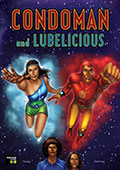Book review: Condoman and Lubelicious
Book review: Condoman and Lubelicious
HIV Australia | Vol. 11 No. 3 | October 2013
Aboriginal and Torres Strait Islander people are advised that this article of HIV Australia contains names of people who have passed away.
Since the late 80s, the Aboriginal community has worked tirelessly to find effective models of education for use in the community that give clear and concise health promotion messages.
 Condoman and Lubelicious is the second comic book in a series that deals with the difficult topic of HIV and sexual health in our communities.
Condoman and Lubelicious is the second comic book in a series that deals with the difficult topic of HIV and sexual health in our communities.
The concept of Condoman was first designed and developed in North Queensland in the early 90s by a very talented and dedicated woman by the name of Gracelyn Smallwood.
Her aim was to create a superhero character that would spread safe sex messages and education about HIV and sexual health in Aboriginal and Torres Strait Islander communities in Queensland.
This led her to create Condoman, a caped crusader superhero decked out in Aboriginal colours; a character designed to be used by Aboriginal and Torres Strait Islander Health workers to provide an engaging form of health promotion.
The process of creating the story for the comic involved running workshops with Indigenous people in Brisbane. This helped to ensure that the comic is culturally appropriate and engaging.
The style of language is effective and culturally correct – in both English and Aboriginal English, with a small amount of Torres Strait Islander Creole.
The language used is fluent and engages the reader with many thought-provoking storylines.
Descriptive language is used to provide detail of specific and sometimes difficult areas to address in sexual health education and prevention and in overall community health.
It is excellent to see the Spiritual Leaders depicted throughout the comics.
This imagery of spiritual leaders from the First Peoples of the world gives a very significant cultural tone to the comic, and gives it the ability to reach many in the target populations – and also lends the comic for use in international settings in the future.
It is also great to see Condoman and Lubelicious superhero suits in both the Aboriginal and Torres Strait Islander colours; this automatically attracts the target population.
The information provided about each sexually transmitted infection is current and clear and provides good, thought stimulating information that can lead our people to be correctly informed.
I really like the concept of sexually transmitted infections having aliases, as this shows the fact that these infections can be dormant and deceitful and can take on many disguises … the comic uses an equal mix of male and female figures to show that STIs are not sexually biased.
The comic also provides accurate information to help individuals make good informed choices about risk behaviours, whether they be sexual or about recreational drug and alcohol use.
The fact that Condoman and Lubelicious are ‘normal’ people in the community that can morph into superheroes to combat all forms of sexually transmitted infections is brilliant, and shows that anyone in the community can take responsibility to help fight for the eradication of sexually transmissible infections through good, sound health education and health promotion.
In closing, I believe that these comics should be funded at a national level (by the Commonwealth) to be utilised in sexual health education and promotion in schools, youth centres and health centres for the whole Australian population.
Congratulations to all the talented people at Queensland Association of Healthy Communities (QAHC), Queensland Aboriginal and Islander Health Council (QAIHC) and Inception Strategies who worked so hard to develop such an informative and engaging health promotion resource!
Reviewed by Neville Fazulla, gay community member. The views expressed in this column are the personal views of the author.
Neville Fazulla is an Indigenous Australian with an extensive and varied career working with and representing Indigenous and gay communities.
Over 21 years he has held staff or Board positions at organisations including Aboriginal Health and Medical Research Council of New South Wales, the Aboriginal Health Council of South Australia, the AIDS Council of South Australia, Queensland AIDS Council, People Living with HIV/AIDS South Australia, National Association of People Living with HIV Australia, Australian Federation of AIDS Organisations and many others.
He has also been a community representative and spokesperson on numerous steering committees and community networks around the country.

